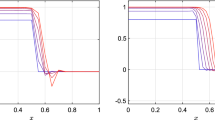Abstract
The question under study is the existence and uniqueness of a non-trivial bounded steady state of a Fisher-KPP equation involving a fractional Laplacian \((-\Delta )^\alpha \) in a fragmented domain with exterior Dirichlet conditions. Of particular interest here is the rigidity on the steady states entailed by the nonlocal dispersion. Our results also provide criteria on the domain for the subsistence of a species subject to a nonlocal diffusion in a fragmented area. Further effects, such as the continuity of this principal eigenvalue with respect to the distance between two compact patches in the one dimensional case, are presented.


Similar content being viewed by others
References
Fisher, R.A.: The wave of advance of advantageous genes. Ann. Eugen. 7(4), 355–369 (1937). https://doi.org/10.1111/j.1469-1809.1937.tb02153.x
Kolmogorov, A., Petrovskii, I., Piscunov, N.: A study of the equation of diffusion with increase in the quantity of matter, and its application to a biological problem. Byul. Moskovskogo Gos. Univ. 1(6), 1–25 (1938)
Smoller, J.: Shock Waves and Reaction-diffusion Equations. Grundlehren der Mathematischen Wissenschaften [Fundamental Principles of Mathematical Science], vol. 258, p. 581. Springer (1983)
Berestycki, H.: Le nombre de solutions de certains problèmes semi-linéaires elliptiques. J. Funct. Anal. 40(1), 1–29 (1981). https://doi.org/10.1016/0022-1236(81)90069-0
Berestycki, H., Hamel, F., Roques, L.: Analysis of the periodically fragmented environment model: I-“Species persistence. J. Math. Biol. 51, 75–113 (2005)
Caffarelli, L., Silvestre, L.: An extension problem related to the fractional Laplacian. Comm. Part. Differ. Equ. 32(7–9), 1245–1260 (2007). https://doi.org/10.1080/03605300600987306
Tartar, L.: An Introduction to Sobolev Spaces and Interpolation Spaces, Berlin; Heidelberg (2010)
Di Nezza, E., Palatucci, G., Valdinoci, E.: Hitchhiker’s guide to the fractional Sobolev spaces. Bull. Sci. Math. 136(5), 521–573 (2012). https://doi.org/10.1016/j.bulsci.2011.12.004
Berestycki, H., Coville, J., Vo, H.-H.: Persistence criteria for populations with non-local dispersion. J. Math. Biol. 72(7), 1693–1745 (2016). https://doi.org/10.1007/s00285-015-0911-2
Berestycki, H., Rossi, L.: Generalizations and properties of the principal eigenvalue of elliptic operators in unbounded domains. Comm. Pure Appl. Math. 68(6), 1014–1065 (2015). https://doi.org/10.1002/cpa.21536
Brasseur, J.: The role of the range of dispersal in a nonlocal fisher-KPP equation: an asymptotic analysis. Commun. Contemp. Math. 23(03), 2050032 (2021). https://doi.org/10.1142/S0219199720500327
Abatangelo, L., Felli, V., Noris, B.: On simple eigenvalues of the fractional Laplacian under removal of small fractional capacity sets. Commun. Contemp. Math. 22, 1950071 (2020)
Felli, V., Noris, B., Ognibene, R.: Eigenvalues of the Laplacian with moving mixed boundary conditions: the case of disappearing Dirichlet region. Calc. Var. Part. Differ. Equ. 60, 1–3 (2021)
Léculier, A., Mirrahimi, S., Roquejoffre, J.-M.: Propagation in a fractional reaction–diffusion equation in a periodically hostile environment. J. Dyn. Diff. Equ. 33(2), 863–890 (2020)
Bogdan, K.: The boundary Harnack principle for the fractional Laplacian. Stud. Math. 123(1), 43–80 (1997). https://doi.org/10.4064/sm-123-1-43-80
Ros-Oton, X., Serra, J.: The Dirichlet problem for the fractional Laplacian: regularity up to the boundary. J. Math. Pures Appl.(9) 101(3), 275–302 (2014)
Greco, A., Servadei, R.: Hopf’s lemma and constrained radial symmetry for the fractional Laplacian. Math. Res. Lett. 23(3), 863–885 (2016)
Silvestre, L.: Hölder estimates for solutions of integro differential equations like the fractional Laplace. Indiana Univ. Math. J. 55, 1155–1174 (2006)
Caffarelli, L., Silvestre, L.: Regularity theory for fully nonlinear integro-differential equations. Comm. Pure Appl. Math. 62(5), 597–638 (2009). https://doi.org/10.1002/cpa.20274
Serrin, J.: Removable singularities of solutions of elliptic equations. Arch. Ration. Mech. Anal. 17, 67–78 (1964). https://doi.org/10.1007/BF00283867
Heinonen, J., Kilpeläinen, T., Martio, O.: Nonlinear Potential Theory of Degenerate Elliptic Equations. Oxford Mathematical Monographs, p. 363 ( 1993). Oxford Science Publications
Author information
Authors and Affiliations
Corresponding author
Additional information
Communicated by X. Ros-Oton.
Publisher's Note
Springer Nature remains neutral with regard to jurisdictional claims in published maps and institutional affiliations.
Appendix A Proof of Lemma 1
Appendix A Proof of Lemma 1
We provide here the proof of Lemma 1. Before giving the proof, we introduce a new notation:
Notation
For all \(\phi \in H^\alpha _0 (\Omega _{1,2,\mu })\) and \(i \in \left\{ 1,2 \right\} \), we will denote by \(\phi ^i\) the function \(\phi \) restricted to the set \(\Omega _i\) and extended by 0 outside \(\Omega _i\)
We also denote by \({\underline{\lambda }}_i\) the principal eigenvalue of \((-\Delta )^\alpha - I\) in \(\Omega _i\) with 0 exterior Dirichlet conditions.
Remark 4
For all \(\phi \in H^\alpha _0(\Omega _{1,2,\mu })\), we have
Proof
The aim of the proof is to prove that for \(\mu \) large enough, there exists \(C>0\) such that
The conclusion follows by the intermediate value Theorem. We start from the Rayleigh quotient defining \({\underline{\lambda }}_{i, \alpha }\):
We continue in the same way by rewriting \(\lambda _{1,2,\mu ,\alpha }\):
Thus, we have found:
We rewrite \(I_1\) and \(I_2\) in order to involving the expression of \({\underline{\lambda }}_{1,\alpha }\) and \({\underline{\lambda }}_{2,\alpha }\). We begin by rewriting \(I_1\):
Finally, we find that
With similar computations, we find that for \(I_2\):
Combining (A.2) and (A.3) in (A.1), we deduce
But, for \(i \in \left\{ 1,2 \right\} \), we have for all \(x \in \Omega _i\) and \( y \in \Omega _{3-i}\)
We deduce that
Since \(\min ({\underline{\lambda }}_{1,\alpha }, {\underline{\lambda }}_{2,\alpha })>0\), we deduce the existence of \(\mu _1>0\) such that for all \(\mu > \mu _1\),
\(\square \)
Rights and permissions
Springer Nature or its licensor (e.g. a society or other partner) holds exclusive rights to this article under a publishing agreement with the author(s) or other rightsholder(s); author self-archiving of the accepted manuscript version of this article is solely governed by the terms of such publishing agreement and applicable law.
About this article
Cite this article
Léculier, A., Roquejoffre, JM. Some effects of nonlocal diffusion on the solutions of Fisher-KPP equations in disconnected domains. Calc. Var. 62, 30 (2023). https://doi.org/10.1007/s00526-022-02374-6
Received:
Accepted:
Published:
DOI: https://doi.org/10.1007/s00526-022-02374-6



